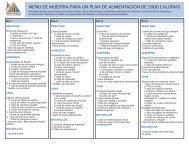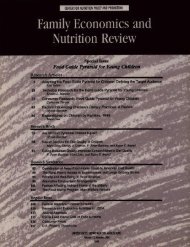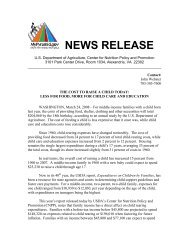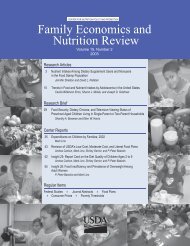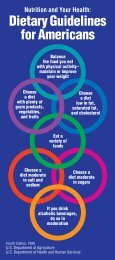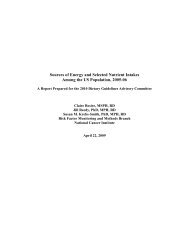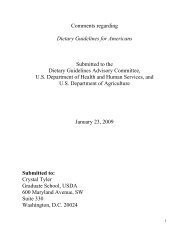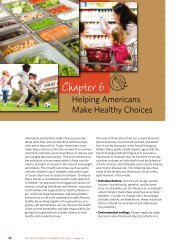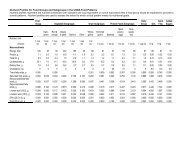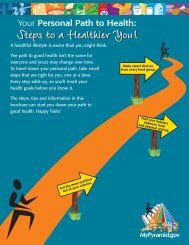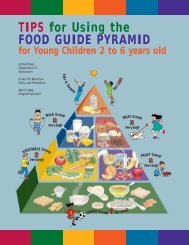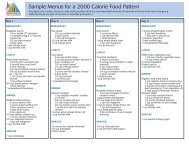Elderly Nutrition - Center for Nutrition Policy and Promotion - US ...
Elderly Nutrition - Center for Nutrition Policy and Promotion - US ...
Elderly Nutrition - Center for Nutrition Policy and Promotion - US ...
You also want an ePaper? Increase the reach of your titles
YUMPU automatically turns print PDFs into web optimized ePapers that Google loves.
food sufficiency question (3.9 percent).<br />
Unlike the scaling analysis, however,<br />
this analysis included households that<br />
denied or affirmed all scale items, so<br />
the sample sizes were large in spite of<br />
restricting the analysis to 2 years of<br />
data: 13,078 elderly-only households<br />
<strong>and</strong> 59,203 nonelderly households.<br />
Other Indicators of Unmet Food<br />
Needs Among Food-Secure<br />
<strong>Elderly</strong> <strong>and</strong> Nonelderly<br />
Households<br />
Some households turn to Federal or<br />
community food assistance programs<br />
when they have insufficient money <strong>and</strong><br />
other resources <strong>for</strong> food. Households<br />
that use these programs <strong>and</strong> are<br />
classified as food-secure may either<br />
have underreported the extent to which<br />
they are food insecure or may have<br />
depended on these programs to get<br />
enough food to be food-secure. To<br />
assess the extent of these conditions,<br />
I compared the proportions of foodsecure<br />
elderly-only <strong>and</strong> nonelderly<br />
households that used four food<br />
assistance programs that are available<br />
to elderly-only households <strong>and</strong> are<br />
reported in the CPS-FSS: the Food<br />
Stamp Program, senior meals (either<br />
Meals on Wheels or meals at a senior<br />
center), getting emergency food from<br />
a food pantry, <strong>and</strong> eating meals at an<br />
emergency soup kitchen.<br />
CPS-FSS data from the 1998, 1999,<br />
<strong>and</strong> 2000 surveys were combined <strong>for</strong><br />
this analysis. Most households with<br />
annual incomes above about 185<br />
percent of the Federal poverty line were<br />
not asked questions about their use of<br />
food programs, so the analysis was<br />
restricted to households with incomes<br />
below this level. The 3-year CPS-FSS<br />
sample of low-income food-secure<br />
households consisted of 7,072 elderlyonly<br />
households <strong>and</strong> 14,524 nonelderly<br />
households. For the analysis of food<br />
stamp participation, the analysis was<br />
further restricted to households with<br />
annual incomes below 130 percent of<br />
the Federal poverty line to exclude<br />
most households that were not incomeeligible<br />
<strong>for</strong> food stamps. This sample<br />
consisted of 3,467 elderly-only<br />
households <strong>and</strong> 9,152 nonelderly<br />
households.<br />
Results<br />
Scaling Analysis<br />
The response patterns of elderly-only<br />
households reflected greater consistency<br />
with the severity order of the<br />
items than did those of nonelderly<br />
households. With the dispersion of<br />
item scores equated, the discrimination<br />
parameter was 1.25 <strong>for</strong> elderly-only<br />
households versus 1.02 <strong>for</strong> nonelderly<br />
households (table 1). This indicates<br />
somewhat greater consistency in the<br />
way in which the elderly experience<br />
<strong>and</strong> manage food insecurity <strong>and</strong> may<br />
also indicate more consistent underst<strong>and</strong>ing<br />
of the questions by elderly<br />
respondents.<br />
Item-fit statistics confirm that the<br />
greater consistency of elderly-only<br />
responses was generally true <strong>for</strong> all<br />
items in the scale. There are no hard<strong>and</strong>-fast<br />
rules <strong>for</strong> assessing item-fit<br />
statistics, but infits in the range of 0.8<br />
to 1.2 are generally considered to be<br />
quite good, <strong>and</strong> 0.7 to 1.3 may be<br />
acceptable (Hamilton et al., 1997b;<br />
Linacre & Wright, 1994). Infit statistics<br />
<strong>for</strong> both samples were within an<br />
acceptable range <strong>and</strong> were remarkably<br />
similar between the two age groups <strong>for</strong><br />
corresponding items. 2 The outfit<br />
statistic <strong>for</strong> “Worried food would run<br />
out” was somewhat high (indicating<br />
erratic responses) in both samples but<br />
less so in the elderly sample. The most<br />
2<br />
The lower-than-expected infits <strong>for</strong> the two pairs<br />
of mutually dependent items (the frequency-ofoccurrence<br />
follow-up items <strong>and</strong> their base items)<br />
in both scales are artifacts of the statistical<br />
dependence of these items.<br />
Results of the scaling analysis<br />
allay concerns that the st<strong>and</strong>ard<br />
scale underreports the prevalence<br />
of food insecurity <strong>and</strong> hunger<br />
among the elderly because of<br />
differences in how they interpret<br />
<strong>and</strong> respond to the questions in<br />
the Food Security Survey Module.<br />
2003 Vol. 15 No. 1 39



